Of all the Crossrail stations, the most controversial has to be Bond Street – as it’s so behind schedule that it might not open when the Elizabeth line’s own delayed opening takes place.
It shouldn’t be so far behind schedule, as although it’s being built in a very tight space with lots of other tunnels around, it’s still fairly similar to the other stations in central London. Two surface buildings for new station entrances, and a series of long tunnels linking them up below ground, and a connection to the London Underground.
So why is Bond Street now famously so late that it might not open with the rest of the line?
Although not announced at the time, a lot of the delay was known about back in 2014 due to a long delay with the initial station box construction and tunnelling. They had expected to catch up on the lost time, but that failed to deliver, so a problem back in 2014 cascaded along the timeline to the point where they have barely recovered any of the lost time.
In construction project management, where everything is planned in fine detail, a long delay is a disaster, as it means all the other contractors need to shuffle their deliveries, and they might have other contracts to deliver when Crossrail was hoping to use them.
It’s not easy to say to a supplier, oh just come back with your team of fitters in six months please.
The issue with the tunnelling lays in part with how the station was designed to be built — as a top-down construction from the surface down to the train tunnels. The intention was for the train tunnels to be there when the station box reached deep enough, then they would break out the tunnel linings to create the new platforms.
Not only were there delays in the tunnelling and redesigns required as they found unexpected issues, but they also had to dig more access tunnels — to a higher specification than expected for access tunnels in order to do some additional unexpected works.
Why this wasn’t made clear at the time the delays occurred is what a lot of Crossrail post-mortem reports will be looking at.
In a positive development, following the Grenfell tower disaster of June 2017, new fire safety standards were introduced, resulting in some of the final fittings that had already been installed at Bond Street (and other stations) being removed to install additional layers of fire protection behind them.
It’s not that the cladding used inside Crossrail stations was a problem – as it’s made of concrete — but that the air gap behind the cladding needed additional heat barriers added to stop any potential fire migrating further than had already been designed into the system.
One of the reasons why photos of the stations now look so unfinished is that a lot of the finishing had to be removed to add the extra fire protection.
As with the other stations, they are currently racing to get the station to what is known as SC1 status – so that testing of the trains can be carried out with Bond Street being able to deal with emergency evacuations should they happen for real, or for testing.
The core plan at Bond Street is to get it to SC1 status, which is ready for testing – then there’s SC2, which is an essentially finished station being used for large scale trials and staff familiarisation, then SC3 – the final handover.
Due to the delays, Bond Street is currently expected not to be ready to open with the other central section stations, and a plan is now in place to enable the rest of the line and stations to progress ahead and to isolate Bond Street out of the system until it’s ready.
However, they still need to get to SC1 — and a lot of work is going on at the moment to deliver that, even if occasionally they put in temporary systems to hit the deadline for testing.
One example being the radio links for the London Fire Brigade — so long as their surface team can talk to the platform team, they can carry out evacuation tests with a temporary connection while the permanent one is installed.
Likewise, down in the tunnels, although under all the protective sheets the platforms are pretty much finished, some of the side passages that will be used in an evacuation are not, and need to be brought up to the required level to allow people to use them.
They have however reached a point in construction where it’s difficult to get the extra steelwork down to the deep platforms, so it’s being delivered by engineering train, which had to be squeezed in between the testing trains.
At the same time, there are around 40 staff and facilities rooms hidden away from the public side of the station that needs to be finished off, as once the handover takes place, they are less accessible to construction staff.
The emergency staircases are also in their final fit-out for testing, including the ability for them to be slightly pressurized so that any smoke that may be in the tunnels is blocked from entering the stairs – making them safer for people being evacuated. That work needs all the doors to be finished off, and on every other level, the air intakes to pressurize the stairs to be completed.
That’s a lot of work to prepare the station for something that everyone hopes will never be needed.
At the same time, escalators and lifts are being completed. The longest escalator on the Elizabeth line is here at Bond Street, nearly, but not quite nicking the title of longest on the Underground from Angel.
The two western ticket hall has the connection with the Central and Jubilee lines, and here, the escalators will take people to a lower level with a new tunnel that connects with the older tube station.
Lots of fit-out work is going on in the ticket halls, with the floors being prepared for the arrival of the ticket barriers, that particular feature that turns a building from “could be anything” into very definitely a railway station.
The tickets halls are being finished with bronze detailing to give the space a little bit of Mayfair glamour, even if this writer thinks the fins on the columns also look like giant Victorian water heaters.
Over the new eastern ticket hall, Mace is the main contractor on the over site scheme for Great Portland Estates. Ironically, the delay to Crossrail helped the over site team as they could carry out their work on what is an existing building site rather than trying to work around a functioning station with passengers and newspaper sellers.
That’s partly why their building looks so much more complete than the building site behind Bond Street, which is also housing a lot of the staff facilities which are difficult to move elsewhere.
So cramped is space on the building site now that not only are they storing equipment on the platforms (soon to be removed), that they’re using the basement of the development for their new project management team meetings where problems are ironed out and plans agreed. Interestingly, the underground basement is classed as part of the over site development, as it will be part of the office and retail space, with the station facilities starting two floors below ground.
One of the hidden in plain sight aspects of the station is the noise dampening panels. In the ticket halls, the lights in the ceiling are surrounded by noise absorbing panels, but the biggest effect is halfway down the escalators, where there’s barely even an echo at the moment thanks to the ceiling design.
Add in hundreds of humans and it will be barely noticed that the noise level could be even higher than it is.
Among the testing, one set of tests that’s soon to start affects a huge ventilation chimney that will sit within the oversite development behind Bond Street station. Although it’ll be ramped up to full power to check the noise levels for the people living near the station, the main test will be when the ventilation fans run at normal speed, to ensure the offices being built around the shaft won’t shake in daily use.
The occasional disturbance from the fans running at full power would be acceptable, but not daily.
All this work is going on to prepare the mostly hidden back-of-office facilities in the station that will never be seen by the public, just to get it ready for train testing and to get it to the stage where an end date can be seen for the station to go live.
Although Bond Street station is now widely claimed to be up to a year behind the rest of the Elizabeth line, that’s a floating deadline, as the Elizabeth line itself has a 6-month expected opening window, so with a suggested opening of Bond Street by September 2021, it’s actually going to be 6-12 months behind the rest of the stations.
However, there’s a strong sense that they really want the station to open with the rest of the line, as it’s a bit awkward to be the last one at the party when all the other stations opened months ago. That’s what they’re working to achieve now.
Some more photos:
The site access was courtesy of the Costain Skanska joint venture and Crossrail.

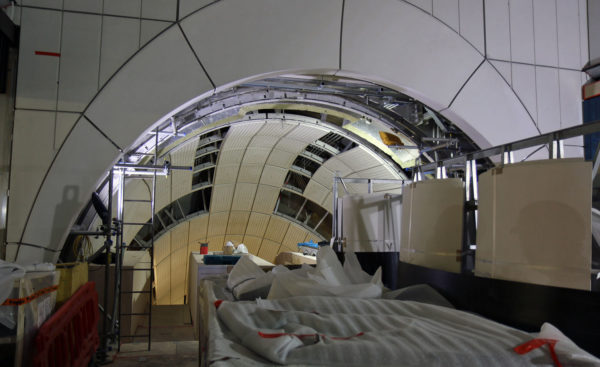

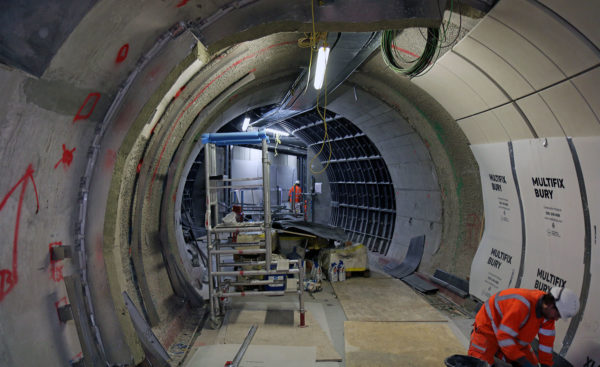
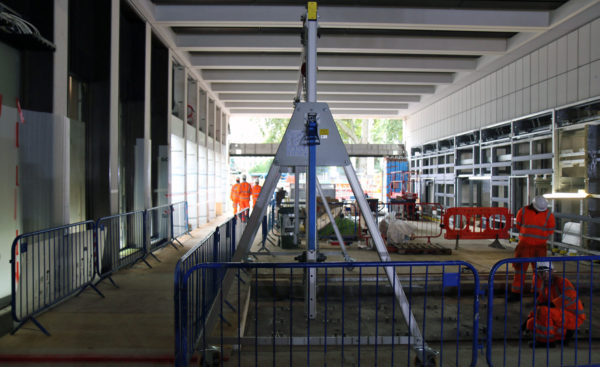
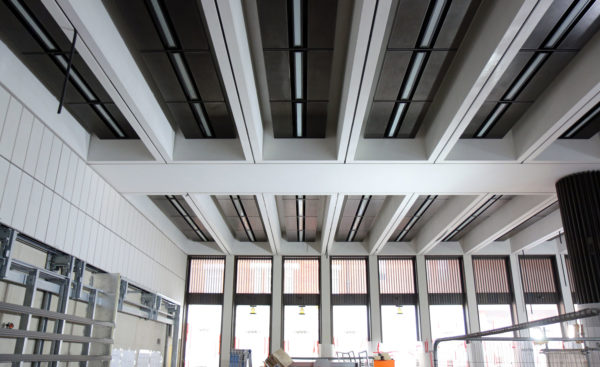
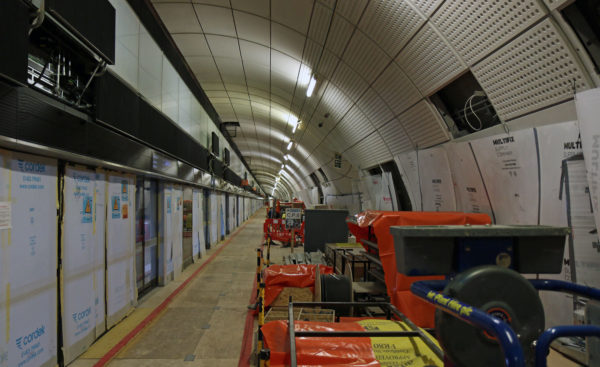
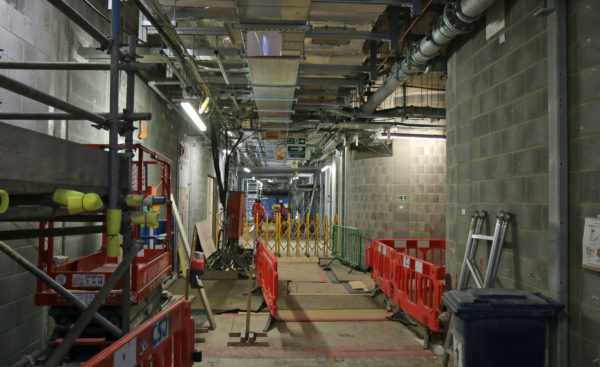
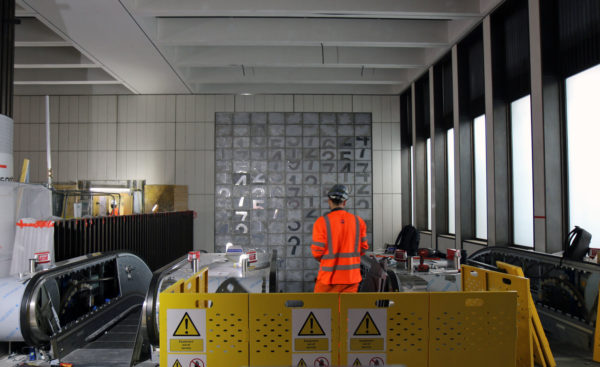
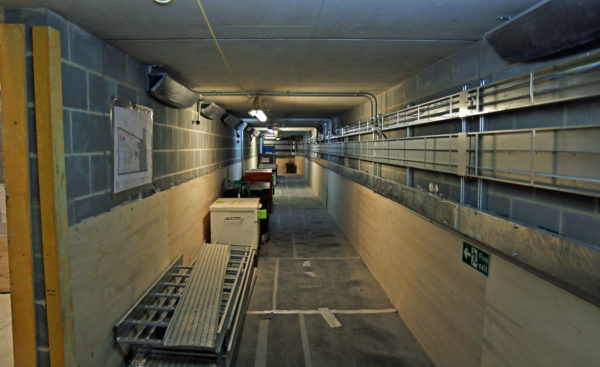
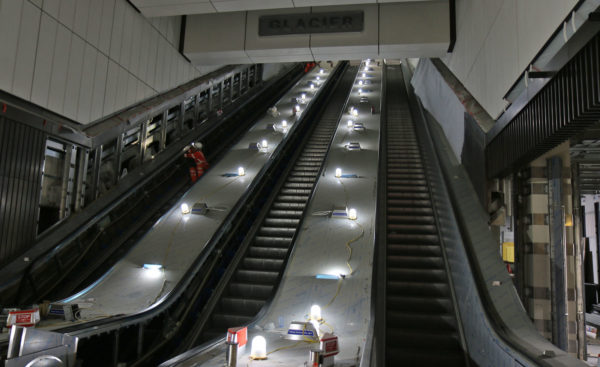
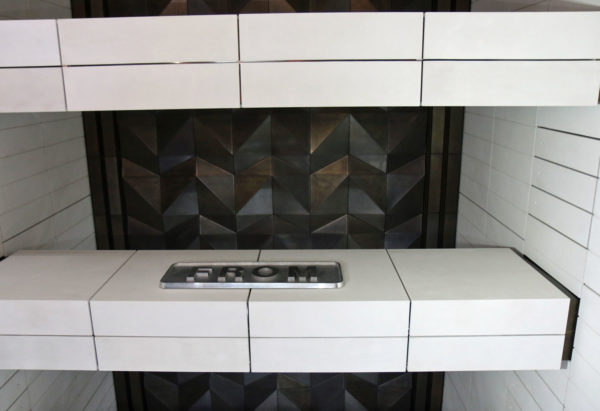
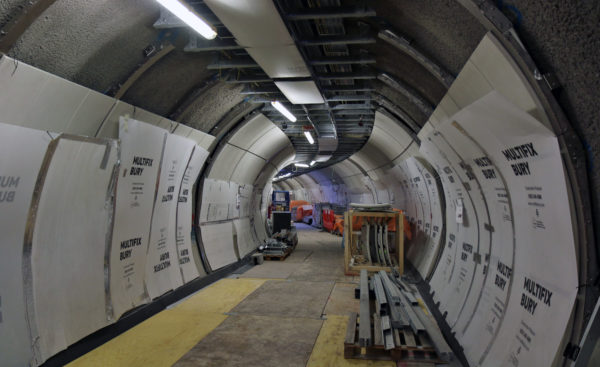
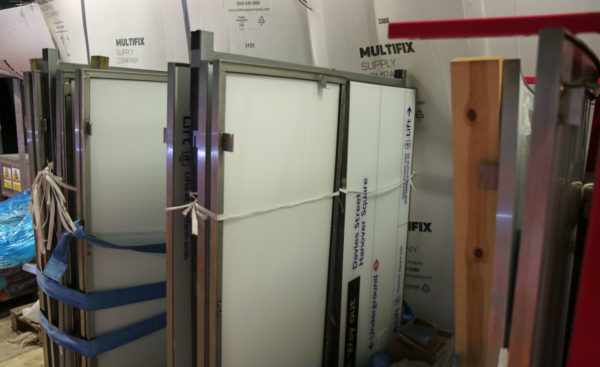
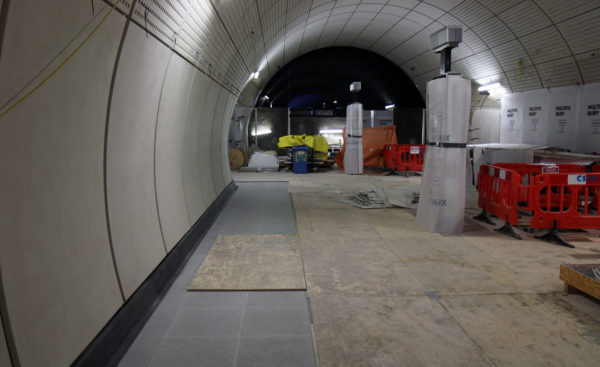
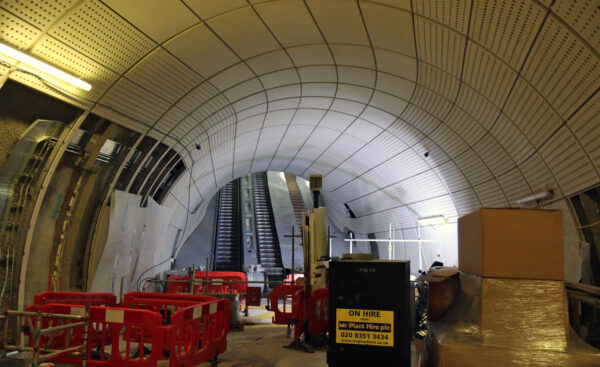
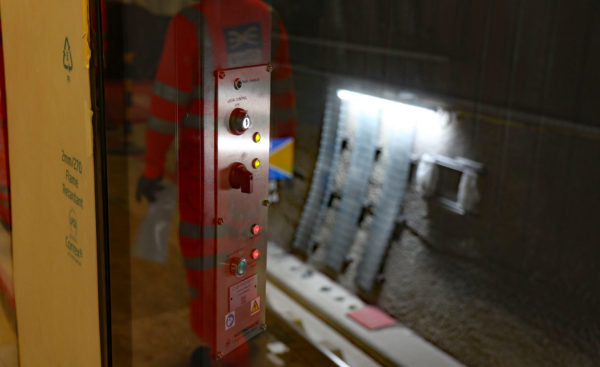
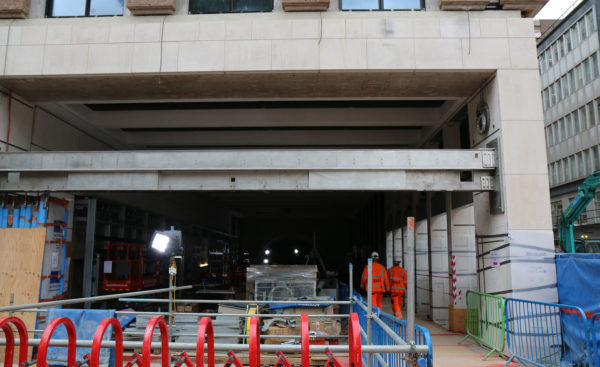
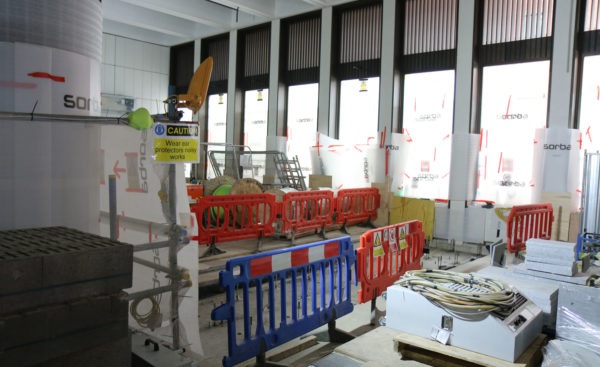






The other issue for sub-contractors on projects with big delays is that they have a massive hole in their schedule which needs filling to pay their staff.
Wow – lots to do there. It would be interesting to take a look at Paddington – my “local” Crossrail station to see the glacial progress visible above ground. I note there is little (if any) weekend work now (there was a time when Eastbourne Terrace was closed at least every Sunday to allow work to be done with less restriction). So probably it’s a way to avoid overtime pay?
Concrete is being poured and service conduits installed along what was (and hopefully will again be) the taxi slip road. This might possibly be done by Christmas (my estimate) which shows just how far behind even the “easy” work is.
TBH, I don’t really care if they ever finish Crossrail at this point. While it may make a visit to Excel more convenient, its benefits are more in the stockbroker belt west and to those in the east. What I would like is having a functional western Paddington station entrance back. Crossrail was supposed to maintain one entrance here (near the Sansburys) but decided it should be stopped up and used as an employee entrance instead – for seven years…
I’ll be glad to see the end of this
“While it may make a visit to Excel more convenient, its benefits are more in the stockbroker belt west and to those in the east.” <-- it adds around 10% extra capacity to the London Underground in the centre of London, which is going to be a huge benefit for people using the Central line and Bakerloo lines at the very least.
Works at Paddington have been absurdly slow. Eastbourne Terrace was first closed to all vehicles but buses in 2009. It was then closed for two full years, supposedly to ‘accelerate works’ between 2012 and 2014. They basically did nothing over those two years, meaning that the street has remained closed since (except some buses, some of the time). As a result, more than 3.5mln diesel fuel buses have been diverted on Westbourne Terrace, an entirely residential street.
The works you are now seeing for the road access will not be a taxi ramp. It is for service vehicles making night deliveries to Paddington station. The taxi stand will permanently be where it currently is. Of course, there is also the illegal one on Praed Street. Presumably, there will be another illegal one on Eastbourne Terrace, if that street is ever reopened.
Very informative article that is the first I’ve seen with detailed information on the challenges to finish the station. Thanks
Can authorities go too far with fire safety systems? Not in my opinion.
Elevators or stairs for people that don’t want to take Escalator!!!
I just wonder if it will be worth using stations like Bond street. There may be time saved by missing out stations on the Central line but how long will it take a passenger to get to the surface at the station? Also the seats on the Elizabeth Line trains are like boards and make my bum sore on short journeys let alone going from Shenfield to Reading for instance.
No one would ever go from Shenfield to Reading on the Elizabeth line as there are considerably faster alternatives. The Lizzy line is a stopping commuter service, not an “intercity” style service.
The issue of the time it will take to get from street to Crossrail train is one I’ve rasied before. Clearly no-one would use it in favout of say the central Line to nip betwene TCR and Bond St but even so.
More vital is so much was ‘missed’, ‘additional’ etc when in the C21 we have amazing geo-civil technology etc to plan and plan and plan before anything hits soil.
Given the choice between the hot Central line and the cool air-conditioned Elizabeth line – I think a lot of people would spend an extra 15 seconds to go for the Lizzy line option.
Freedom Pass holders may prefer to travel free all the way to Reading by Crossrail, despite the longer travel time – and those hard seats.
Fantastic & informative piece on the challenges and progress – thanks v much Ian! Bravo.